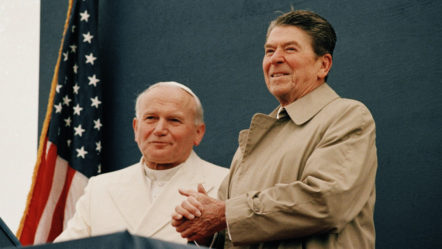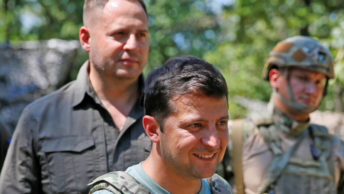After reading Paul Kengor and Robert Orlando’s book Divine Plan, (2019) my long-held belief that all of human history is God’s story of the vicissitudes of billions of people over the course of thousands of years was verified. According to the authors, life must have both destiny and freedom. This traditional idea strikes at the heart of the Darwinian reduction of human history as nothing more than a series of random acts without meaning or purpose.
All the other ideological descendants of the French Revolution, such as Socialism, Communism, Progressivism and even Utopian Sociology, have tried to add a universal purpose with an earthly paradise where people live a world of perfect harmony free of wars, violence, or prejudice of any kind. They never mention, that a strong authoritarian government will be the necessary instrument to transform human nature into a robotic response to stimuli without free will, conscience or moral bearing. It is no more than cake by a lake.
One of the most surprising and nearly forgotten stories of the history of the late 20th century was the intersection of the lives of St. John Paul II, who was pope from 1978-2005 and President Ronald Reagan, who served from 1981-1989. While these two leaders did not share the same exact religious beliefs, their thinking on a metaphysical level was very similar. Both men strongly believed they were God’s instruments. They also had faith in a Divine Plan that applied to nations, not just people. I have often expressed my personal belief in God’s Divine Plan for all of us, most recently in my essay on this site,The Boy in a Uniform. However, nothing in my life has ever risen to the public stage in such dramatic fashion as this historic union of strength, courage and fortitude.
The authors masterfully outline all the pieces that had to fall into place for this Holy Alliance to have materialized. Only hopelessly incurable cynics can avoid the obvious conclusion that the Hand of God was involved in this union of spirit and politics that resulted in the kinship between a pope and a president. It was metaphorically a marriage made in Heaven.
Prior to Reagan’s election in 1980, he was sitting with Richard Allen, his close friend, and future Chief Security advisor. They were watching a newscast of the pope traveling through his homeland in Poland. Allen, who was a Notre Dame graduate, was especially interested in the pope’s unique journey. But it was the Protestant Reagan who had the epiphanous moment. He exclaimed to his stunned friend: That’s it! That’s it!. Reagan knew immediately that a partnership with this young and vital Pope, whose native home had suffered so much, would be the perfect ally to win the Cold War.
The authors also point out that both men had many personal traits in common. Both had been actors on a much smaller stage. This common experience had taught them how to communicate ideas to many people in public venues. When both were elevated to the pinnacle of their professions, they skillfully used their communication talents to relate to millions of people on a personal level. They also firmly believed in the sanctity of the human person. Reagan, who had once signed an abortion bill as Governor in California, changed radically and became the national face for the Pro-life Movement.
The pope and the president believed that freedom was not the right to do whatever one wanted to do but to live the truth of what we are before God, the truth of our identity as children of God, as brothers and sister in common humanity. Instead of directly referring to the Founding Fathers, Reagan quoted philosopher Jacques Maritain on the Founders. They were neither metaphysicians nor theologians, but their philosophy, their notion of natural law and human rights were permeated with concepts worked out by Christian reason.
President Reagan believed that God had a special goal for America, a more beneficent and altruistic kind of manifest destiny than the one that encouraged the expansion of the country from coast to coast, including Mexico. He often quoted Pope Pius XII’s remark: Into the hands of America, God has placed an afflicted mankind. As president he believed deeply in America’s divine exceptionalism. He often repeated his firm belief that America had been chosen to serve God, echoing minister John Winthrop’s sermon in 1630, as a Shinning City on a Hill.
Just as Reagan’s political theology centered on the future of America, John Paul’s centered on his Polish homeland, which had been occupied by the Soviet Union since Yalta in 1945. The authors quoted New York’s Cardinal Timothy Dolan, who knew both men well. On the pontiff, the Cardinal stated that the pope’s goal was not to raise the Iron Curtain per se but to proclaim Jesus Christ as the way of truth and the life. He believed when that happened, the curtain would rise and never fall again.
Reagan had already experienced the problems Communism posed for America first hand when he was the President of SAG, the Screen Actors Guild. Soviet founder, Nicolai Lenin had always emphasized the power of the arts, especially the cinema, as key propaganda targets in the communist vision of world domination. Several hundred communist operatives or sympathizers had infiltrated Hollywood, much to the chagrin of many patriotic actors, producers and directors. Thanks to Reagan’s SAG leadership, the red tide had ceased to flow in Hollywood.
Probably the most revealing facts of the pope and president’s shared destiny, was magnified early in their first act on the world stage. Both came within fractions of being assassinated before their mutual destiny had been carried out. On March 30th, just two months after Reagan’s inauguration as the 40th president of the United States, John Hinckley, Jr. an emotionally disturbed young man, fired several shots at Reagan and his entourage, outside the Hilton Hotel in Washington, D.C. One fragmented ricochet nearly killed the president.
Only months later, on May 13, 1981, as John Paul II traveled in his Fiat Popemobile through the crowd that jammed St. Peters Square, a probable Soviet operative, Mehmet Ali Aga* fired several shots at the Pope that should have killed him. It was over 50 years since the Russian Revolution that would enslave half the world in the chains of communist oppression, had taken place. More importantly, it was the 54th anniversary and Feast Day of Our Lady of Fatima’s apparition to the three shepherd children in Portugal.
Through the heroic work of their respective medical staffs, thousands of miles apart, the Holy Spirit saw to it that both men recovered to perform their God-given job of bringing about the end of the Soviet Union. It was only later that the public realized just how close these two special world leaders had come to dying. In each case, it was mere centimeters that had made the difference. Both nearly bled to death before reaching the hospital. Reagan required eight pints of blood while the pope six pints. Kengor reports that after John Paul’s body rejected his first transfusion, the doctors donated their own blood to save the pontiff. Both leaders unsurprisingly saw their survivals as the work of Divine Providence.
Not long after, Mother Teresa told the president, during a private meeting at the White House that she and her fellow nuns had prayed for two straight nights for him after the shooting. She also told him: You have suffered the passion of the cross and received grace. There is a purpose to all of this. According to Kengor, the statement greatly moved the Reagans. The Great Communicator was silent and his wife Nancy cried.
The pope did not have to be reminded of the coincidence of the date of his near-death experience. He had a special devotion to the Blessed Mother since his earthly mother died when he was eight. In fact, his papal motto was Totus Tuus, meaning totally yours, Mary. He believed that the Blessed Virgin directs our daily journey on earth. The pope also felt there had to be a connection with the Third Secret of Fatima, which had never been revealed.
Her first two Secrets were that the Great War, still raging, would end soon but it would engender a second, even more deadly war. She also warned that Russia will spread its errors throughout the world, raising up wars and persecutions of the Church. The Third Secret proclaimed that that the three shepherd children had seen a vision of a bishop in white, who was killed by a group of soldiers who fired bullets and arrows at him. Immediately, John Paul II realized his own destiny in their vision because the pope is also the Bishop of Rome and the only one who wears white.
There is another point to the Third Secret. The vision had not completely been acted out. The pope had survived. His long-term aide, the future Cardinal Stanislaw Dziwisz, raised the question, couldn’t that have been the real point of the vision? Perhaps it was that the paths of history, of human existence, are not necessarily fixed in advance. The only conclusion is that Providence or a motherly hand…can intervene and cause a shooter, who is certain of hitting his target, to miss. As the pope put it: one hand fired and another guided the bullet. As for the other victim, the president said There’s a reason I’ve been saved. He vowed to make certain the communist world knew it.
Four days after the attempt on the pope’s life, President Reagan gave the graduation address at the University of Notre Dame. He did not talk much about the individual challenges facing these newly minted graduates. His address had a message of world significance, especially when he said: The years ahead are great ones for our country, for the cause of freedom and the spread of civilization. The West won’t contain Communism, it will transcend Communism…It will dismiss it as some bizarre chapter in human history whose last pages are being written.
God had used the assassins’ bullets to forge an indelible bond between the two world leaders. After their mutual recoveries, a pope and an American president joined their forces in a Holy Alliance that would change the world for years to come. No one can dismiss the fact that it had effectively ended the Cold War. These principal actors could not have accomplished this alone. God’s Providence needed many supporting actors, such as Prime Minister Margaret Thacher, Polish political activist, Lech Walesca, Richard Allen, CIA Director William Casey, and Papal Ambassador to Washington, D. C. Archbishop Pio Laghi. Together they established a providential network that would collapse the Soviet Union in a mere generation.
After Reagan left office, the damage to Communism had already begun to flower. Lech Walesca was elected president of a free Poland while the communists did not get a single seat. The Berlin Wall came down and a year later, Mikhail Gorbachev resigned as the last leader of the Soviet Union. Less than 15 years after Reagan had summed up his policy toward the Soviet as we win and they lost, the Cold War was over. Another national security adviser, Bill Clark, was with the president just after the wall tumbled and Reagan modestly said ‘No, I didn’t bring the wall down. That was part of the Divine Plan, teamwork and God’s Will…’ so great was Reagan’s believe in the divine will.
Writer and political consultant, Craig Shirley, summed the situation up perfectly. It is the linchpin of history that John Paul II becomes pope in 1978, Margaret Thatcher become prime minister in 1979 and Ronald Reagan becomes president in 1981. And combined, the three of them changed the course of history. Of this historical triumvirate, Reagan later said it was a team effort. He might have added with God as the Coach who called the plays.
Many historians have referred back to the thinking of 19th century Scottish historian Thomas Carlye, who wrote that the history of the world is but the biography of great men. His thesis evokes visions of Napoleon in the early 19th century in a revolutionary France and Winston Churchill in war-torn England. It is hard to imagine Jimmy Carter or Joe Biden accomplishing what Reagan did nor Pope Paul VI what his successor did. However, their historic coalition has all but vanished from the world scene. All that remains is their historical example, which the Left has tried to cancel for two generations.
Anyone who can read the tea leaves knows that Communism is still with us. It is likened to a plague that will always infect the unsuspecting young. Like Covid-19, it mutates and takes different forms. The Soviet Union fell because history was ripe for its fall. Since then, world leaders have not only allowed but encouraged its new iterations around the globe. Russia has tried to reestablish the Soviet Union since 2014 but that seems to be a failed enterprise at this point.
New risks for the world have crystallized in the People’s Republic of China, a greatly revised but thoroughly materialized imperial ideology that has been advancing in several venues around the world, perhaps within our own government. The world is once again, in need of a new historical triumvirate, leaders who will be able to stand on the shoulders of their three forbears to counter the world that is coming. Right now I do not see any possible candidates but we can only hope and pray.
*The pope later forgave him, and the Italian president Carlo Azeglio Ciampi pardoned him in 2000. He was deported to Turkey where he converted to the Catholic faith. Many of his post-conversion statements have been tainted with bizarre and contradictory statements.








